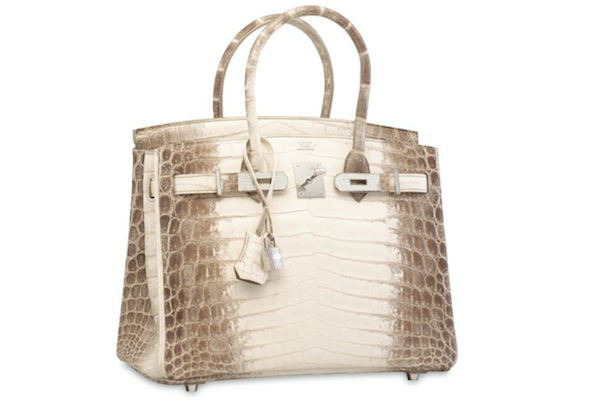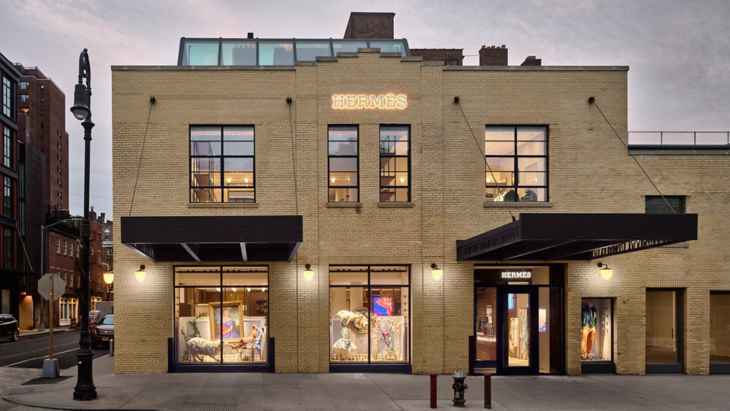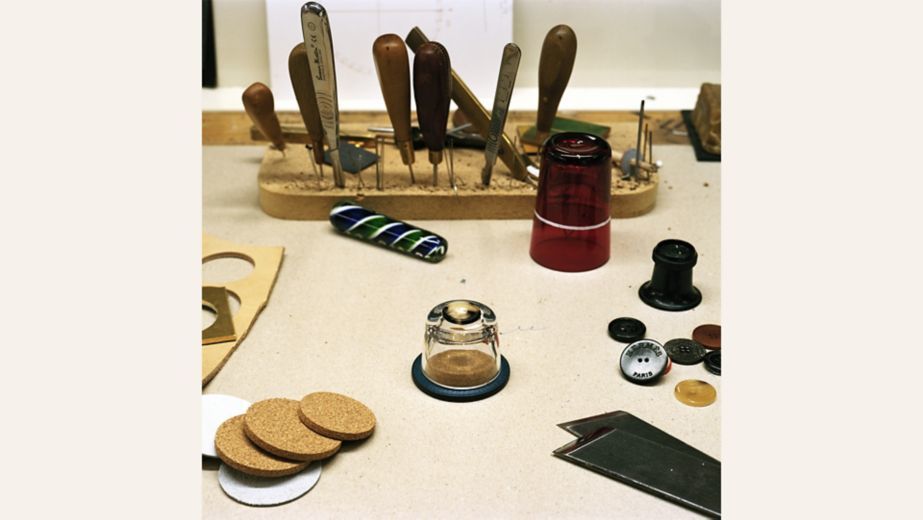FEATURE | Reserved For 182 Years, Does HermУЈs Need To Join The Chase For Young People?
September 20,2019
In China, many luxury brands are sparing no effort to reach out to the younger generation, and are even beginning to тplayт with them: Louis Vuitton released the Endless Runner video game and invited Chinese fashion blogger gogoboi to guest run the brand's official WeChat account. Prada teamed up with artist Cao Fei to create a special project named тCode Humanт. Chanel is already a "senior player" of Tik Tok.
In such a vibrant environment, HermУЈs low key approach is especially surprising. So does today's HermУЈs need to go after young customers to reach out to a wider range of new consumers?
Luxe.Co: Does the 182-year-old HermУЈs need to be younger and more digitized?
You choice:
A.No need.
B.Need.

No Need!
"In the first two quarters of fiscal year 2019, HermУЈs performed well in all regions and across all lines of business." said Axel Dumas, the CEO of HermУЈs and the sixth generation of the family. In the first half of the fiscal year 2019, HermУЈs group's net sales rose 15% to 3.284 billion euros, reflecting year-on-year growth at constant exchange rates of 12%.
For the public, the reason for choosing HermУЈs is simple -- it is undoubtedly the world's top luxury brand.
For the industry, this is an evergreen tree that still maintains the highest operating profit margin in the industry, reaching a staggering 34.3% in the 2018 fiscal year -- which means not only that HermУЈs products enjoy a high brand premium, but also that the company's management and marketing costs remain relatively low.
HermУЈs, who holds the record in the global handbag auction, has proved its authority in the luxury industry with the handbag Himalaya Niloticus Crocodile Diamond Birkin (size 30) fetching nearly $380,000.

The enduring popularity of HermУЈs handbags has also led to an unprecedented enthusiasm for luxury handbags in the secondary market. According to Jefferies, an investment bank, HermУЈs second-hand handbags grew by 432% in the second-hand luxury market between 2010 and 2016. In a survey of consumers by The Real Real for The 2018 Christmas season, HermУЈs became the most popular luxury brand among female consumers, especially the Birkin, Kelly and Constance models, which saw a 7% year-on-year increase in prices.
Both the record set in the auction house and the popularity gained in the second-hand market continue to strengthen the unique brand value of HermУЈs and its irreplaceable position in the hearts of luxury consumers.
Need?
Led by the founding family, employing more than 14,000 people worldwide, HermУЈs continues to enjoy steady sales growth and high profit margins. The challenge ahead of them is on two fronts: growth and innovation.
In the fields of fashion and luxury, brands always need a larger base of users and markets, and adapt to changes and self-innovation.
Todayтs China can be a challenge for HermУЈs:
On the one hand, Chinese consumers have not yet formed a strong brand awareness and loyalty to luxury brands. On the other hand, Chinese consumers are bombarded by numerous new and old brands every day -- these brands are grabbing their attention and drawing their consumption desire and purchasing power.
We often see references such as: "HermУЈs" of cars, "HermУЈs" of restaurants... HermУЈs is often used by other industries to describe its highest standards, and such cross-industry recognition is a level that no other brand can reach. In the short to medium term, HermУЈs doesnтt need to worry about its brand essence be diluted by selling more products. In other words, brands only need to manage the "relative scarcity" between them and market demand.
Therefore, if HermУЈsт exposure frequency is too low, or keeps too much distance with customers, or if there is no way for people to understand or experience HermУЈs' "noble spirit", there is a great risk that it will gradually fade away from the minds of young people, and the emotional connection with users will become weak or even broken.
Today's HermУЈs: Change is Happening Quietly
In every way, it is clear that HermУЈs is quietly seeking change along a carefully chosen path.
- ProductionяМImprove production capacity
- CatagoryяМEnrich entry categories and highlight the lifestyle pyramid
- StoreяМExpand in the China market, tell stories, experience
- MarketingяМExplore online communication and interpret the concept of sustainability
- SalesяМReform the "aging" official website and upgrade the e-commerce business
ProductionяМImprove production capacity
Previously, customers had to wait for years to buy a Birkin. Back in 2008, HermУЈs responded to growing demand by eliminating the waiting list system. In order to improve the supply situation, it was necessary to increase capacity, but at the same time to maintain strict process standards.
In order to solve this problem, the brand has been planning to steadily add leather workshops in France since 2012. This initiative has yielded significant results since the first quarter of 2014, when leather goods returned to double-digit growth.
So far, HermУЈs is still under a measured rate of capacity expansion. Last April, two new leather workshops were opened to boost productivity. In May, HermУЈs opened its 17th handmade leather workshop in the small town of Fitilieu, France. At the same time, leather workshops in Gironde and Seine-et-marne are in the pipeline, each of which will create 250 new jobs and help HermУЈs become more responsive to demand.
CatagoryяМEnrich entry categories and highlight the pyramid of lifestyle
In March 2019, HermУЈs announced that it would launch its first beauty collection in 2020, followed by personal care products. Axel Dumas, the CEO of HermУЈs, has expressed his hope that HermУЈs could become a global company in the field of beauty products. Beauty products, as an entry-level product, are often seen as the door to the world of luxury. If a young girl buys a lipstick today, she is likely to be a loyal customer of Birkin in the future.
Starting with beauty products, HermУЈs will gradually expand into personal care products, while consolidating the existing perfume line. Cosmetics, skincare and perfume will be targeted at preferences in the US, Asia and Europe respectively. Hermes' perfume division, which currently accounts for about 5% of sales, is also in the HermУЈs category for many young entry-level consumers. In 2014, its perfume division carefully launched a diversification strategy, launching the body care line HermУЈ Le Bain on the basis of perfume, which laid the foundation for the launch of beauty products today. Beauty and personal care products will complement perfume in the future, achieving what Axel Dumas calls "growing hand in hand".

Another easily overlooked category is the watch, which accounts for about 3% of HermУЈsт sales. In the first quarter of fiscal year 2019, the watch division posted a year-on-year growth of 22.3%. HermУЈsт watchmaking division, which is just over 40 years old, is relatively young, but it is trying to innovate.
In the hotly contested market for luxury bags, HermУЈs has long built a lifestyle pyramid that no other brand can emulate, from entry-level beauty products to watches and niche designs to furniture.
Home products as the brandтs next core category, recently achieved outstanding growth. In its just-released second-quarter results, HermУЈsт "other business" division --- the Art of Living and HermУЈs Tableware, sales jumped 20.8% year on year.
StoreяМExpand in the China market, tell stories, experience
In April, HermУЈs, which has always been careful about its store location, opened an "alternative" boutique (below) at 46 Gansevoort St in Meatpacking District New York and opened its first in-store coffee bar to embrace the experience for young consumers.

Since 2018, HermУЈs has opened Silk scarves & Vinyl record pop-up stores in Madrid, New York, Seoul and Beijing that silk scarves designs serve as covers for vinyl records, drawing young consumers' attention to the integration of scarves with music and art.
Last week, HermУЈs opened a new store in Xiamen, China, which combines the style of "Hakka Earth Building" and invited artisans to show the production process of the brand's products. How can customers better understand HermУЈs level craftsmanship? The most direct way is to get close to the craftsmen and producers.

This is the 26th outlet in China for HermУЈs, which is known for its careful channel expansion strategy (below). The opening of this store echoes Axel Dumas's important strategic plan for the China market in June this year: "Strive to open a new city every year".
Looking back at HermУЈsт recent financial results, "China" has been the focus of the brand's international expansion -- even as the global luxury industry slowed in 2012 and only two new stores opened globally, both of which were located in China (Wuhan and Taiwan). While this careful international offline channel expansion strategy continues, HermУЈs still adhering to the principle of "quality over quantity". But for the China market, HermУЈs is very open -- up to the 2018 fiscal year, the brand has opened new stores in Hong Kong, Changsha, Xiтan, and renovated and expanded their Shanghai IFC store. In 2019, the brand opened its 26th store in Xiamen China.
Axel Dumas revealed that the brand's Chinese customers are getting younger and younger, and they have become the youngest group of HermУЈs customers.
MarketingяМExplore online communication and interpret the concept of sustainability
How to tell the brand's story to younger generation in new media and new ways is one of HermУЈsт biggest challenges. On Weibo, comments and interaction rates on HermУЈsт official account are lower than others. Intentionally or unintentionally, HermУЈs maintains a subtle distance from social media users.
In reality, HermУЈs has been doing online marketing in China in the past two years. For example, building an online store for silk scarves, the 2015 arm-wrestling contest (show bracelet), and advertising on WeChat Moments on Chinese Valentine's Day.
In terms of social responsibility, sustainability is also one of the challenges for HermУЈs. From focusing on animal welfare and strengthening requirements and regulations for crocodile skin suppliers, to sustainable use of natural raw materials such as horse mane hair, to the community power of its 52 French workshops, HermУЈs has never stopped innovating in the field of sustainability. In recent years, consumers now have a more concrete understanding of this concept through the form of "Festival des metiers".
It is worth mentioning that the concept laboratory --- Petit h, founded in 2010 by Pascale Mussard, the sixth generation successor of HermУЈs family, is one of the sustainable innovations of the brand. It uses leftover crocodile skins and other leftover materials from HermУЈs to make creative products, each of which is unique.

SalesяМReform the "aging" official website and upgrade the e-commerce business
Perhaps many may have forgotten that in 2001, HermУЈs was the first luxury brand in the industry to launch an e-commerce site.
Last year, HermУЈs official website, which was once criticized as "aging", completed its upgrade, which gave the brand a qualitative leap in its e-commerce business, which previously had long lagged behind its peers. In the same year, its official e-commerce website in China was launched.
In the first half of the fiscal year by June 30 this year, Axel Dumas highlighted the fact that the online channel in China has brought much more traffic and sales to HermУЈs than expected. In addition, Axel Dumas also said that he is considering the establishment of cooperation with local e-commerce companies in China, given the local characteristics of the digital luxury in China.
HermУЈs may not be changing the fastest, but the brand's past and current moves suggest it is trying to use subtle moves to keep the market hot while maintaining relative scarcity. At the same time, it is also looking for the right type of online marketing to build stronger emotional connections with more new consumers.












Comments